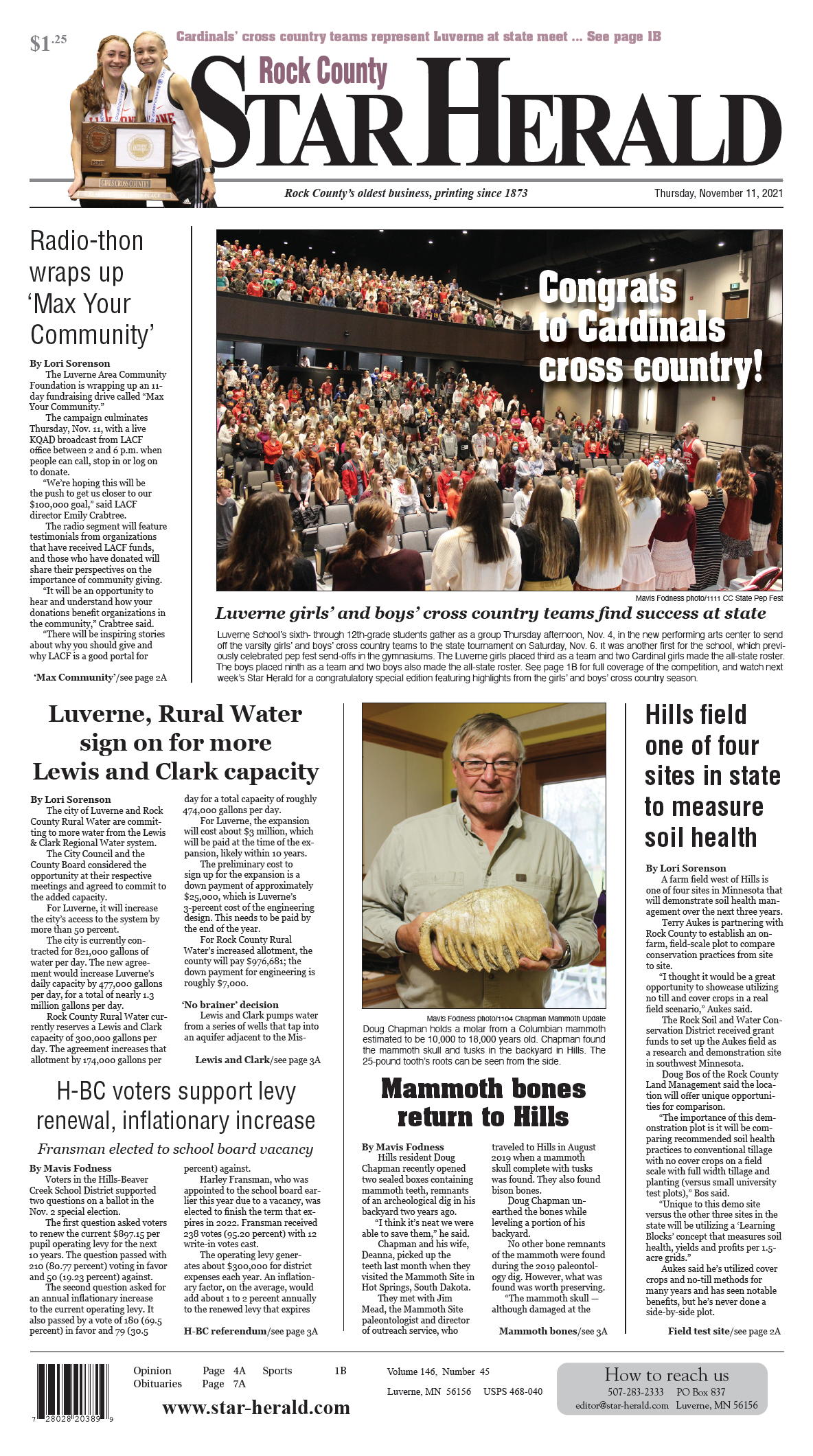St. Catherine Catholic Church
203 E. Brown St., Luverne
St. Catherine Ph. 283-8502; www.stscl.org
Monsignor Gerald Kosse, Pastor
Sundays 8:30 a.m. Mass. Public Mass will be celebrated at FULL capacity in the church. Masses: 9 a.m. Wednesdays, 10 a.m. Friday at the nursing homes – check the bulletin. All Sunday masses will be live streamed on Facebook at https://www.facebook.com/pg/stccluverne/videos/. Visit www.stscl.org for more information.
Luverne Christian Reformed Church
605 N. Estey St., Luverne
Office Ph. 283-8482; Prayer Line Ph. 449-5982
www.luvernecrc.com — office@luvernecrc.com
Sundays 9:30 a.m. Worship service. 6:30 p.m. Evening worship service. We are streaming Sunday services live on YouTube at 9:30 a.m. and 6:30 p.m. Send him a friend request if you’re not connected. You may also visit our website for delayed broadcasts. Also our services are on local cable TV at 5:30 p.m. on Wednesdays and at 6:30 p.m. on Thursdays. In all circumstances, may we joyfully declare: “Our help is in the name of the Lord, the Maker of heaven and earth.” Psalm 124:8.
First Baptist Church
103 N. Jackson St., P.O. Box 975, Luverne
Ph. 283-4091; email: fbcluv@iw.net — www.fbcluverne.org
Walt Moser, Pastor
Sundays, 10:30 a.m. In-person worship service. Service is also on Facebook Live at 10:30 a.m.
Grace Lutheran Church
500 N. Kniss Ave., Luverne
Ph. 507-283-4431; www.graceluverne.org — graceluverne@iw.net
Ann Zastrow, Pastor
Dave Christenson, Interim Pastor
Thursday, Nov. 18: 8:30 a.m. Missions in Action. Sunday, Nov. 21: 9 a.m. Worship service with Holy Communion. 10 a.m. Semi-Annual meeting. Fellowship Coffee. 10 a.m. Sunday School. 10-10:30 a.m. Older instrumentalists meet with Janine. 10:30-11 a.m. Christmas program practice. 5 p.m. Worship service. 5:30 p.m. 9th-12th Friendsgiving supper. 6:30 p.m. Worship practice. Monday, Nov. 22: Grace Notes deadline. Tuesday, Nov. 23: 9 a.m. Staff meeting. Wednesday, Nov. 24: 7 a.m. Men’s Bible study. Thanksgiving Break—No Faithweavers and no Confirmation. 3-8 p.m. Pizza Ranch Tip Night. Online, TV and Radio Worship options are available. Online: Sundays 9 a.m. on the church website www.graceluverne.org, click Worship tab or go directly to our Facebook page at Grace Lutheran ELCA, Luverne. TV: Vast Channel 3 will air our worship service Mondays at 4:30 p.m. and Fridays at 10 a.m. Radio: KQAD-AM Radio will air our worship service on Sundays at 8:15 a.m.
Bethany Lutheran Church
720 N. Kniss Ave., Luverne
Ph. 507-283-4571 or 605-215-9834
pastorapalmquist67@yahoo.com
Andrew Palmquist, Pastor
Sundays, 10:15 a.m. Worship service; worship online as well (at els.org). Tuesdays, 6:30 p.m. Zoom Bible study. See our Facebook page, Bethany Lutheran Church (Luverne) for other classes and events.
American Reformed Church
304 N. Fairview Dr., Luverne
Ph. 283-8600; email: office@arcluverne.org
Thursday, Nov. 18: 9 a.m. Cookie Crew. Friday, Nov. 19: 6:30 a.m. Community men’s Bible study. Sunday, Nov. 21: 9:30 a.m. Worship service. NO Sunday School. 1:30 and 2:15 p.m. Mary Jane Brown and Poplar Creek worship services. 3 p.m. Youth room reserved. Monday, Nov. 22: 8:15 p.m. Cantata rehearsal. Tuesday, Nov. 23: 12 p.m. Staff meeting. 7 p.m. Consistory meeting. Wednesday, Nov. 24: 7 p.m. Thanksgiving Eve worship service. Thursday, Nov. 25: Commons reserved; youth room reserved. Services are also broadcast on Vast Channel 3 on Mondays at 6 p.m. and Wednesdays at 4 p.m. DVD’s available upon request. To stay up to date on announcements, follow us on Facebook and Instagram @arcluverne.
Rock River Community Church (formerly First Assembly of God)
1075 110th Ave., 2 miles west of Luverne on County Rd. 4
Ph. 612-800-1255; email info@rockrivercommunity.church
Bob Junak, Pastor; Annette Junak, Assistant Pastor
Sundays, 9 a.m. Sunday school; 10 a.m. Worship service. Children’s church for ages 3-6th grade and nursery for ages 0-3 provided during our services. Wednesdays, 7 p.m. Worship service. All services are in-person and all are welcome.
United Methodist Church
109 N. Freeman Ave., Luverne
Ph. 283-4529
Dorrie Hall, Pastor
Wednesday, Nov. 17: 6:15 p.m. FUEL. 6:30 p.m. Confirmation. 8 p.m. AA Meeting. Saturday, Nov. 20: 8 p.m. AA meeting. Sunday, Nov. 21: 9:30 a.m. Adult Sunday school. 9:45 a.m. Coffee hour. 10:30 a.m. Worship Service. 4:30 p.m. Genesis/Revelation Bible study. 6:30 p.m. Alive youth group. Live streamed on Facebook and radio. Monday, Nov. 21: Messenger deadline. Wednesday, Nov. 24: 5:30 p.m. Community meal. 8 p.m. AA Meeting.
First Presbyterian Church
302 Central Lane, Luverne
Ph. 283-4787; email: Firstpc@iw.net— www.fpcluverne.com
Jason Cunningham, Pastor
Sunday, Nov. 21: 9:30 a.m. Worship service. 10:30 a.m. Sunday school. 10:45 a.m. Music staff. Wednesday, Nov. 24: No bells or choir. Deacons meeting. In-person Worship service and live on Facebook. Our Facebook page can be found under First Presbyterian Church of Luverne. We are also on the local Luverne cable station at 10 a.m. and 6 p.m. on Tuesdays and 10 a.m. on Thursdays.
St. John Lutheran Church
803 N. Cedar St., Luverne
Ph. 283-2316; email: stjohn@iw.net
www.stjohnlutheranluverne.org
Rev. Dr. Phil Booe, Pastor
Saturday, Nov. 20: 5:30 p.m. Worship. Sunday, Nov. 21: 9 a.m. Worship service. 10:15 a.m. Adult Bible study. Services will be available on the Vast Channel 3 Sunday and online at the city website, cityofluverne.org.
Living Rock Church
500 E. Main St., Luverne
Ph. 449-0057; www.livingrockswmn.org
Billy Skaggs, Pastor
New Life Celebration Church
101 W. Maple, Luverne
Ph. (605) 368-1924; email: newlifecelebration@gmail.com
Food mission every third Thursday.
Zion Evangelical Lutheran Church
305 E. 2nd St., P.O. Box 36, Hardwick
Ph. (507) 669-2855; zionoffice@alliancecom.net
Jesse Baker, Pastor
Wednesday, Nov. 17: 6 p.m. Confirmation. Sunday, Nov. 21: 9 a.m. Worship service with communion. 10:15 a.m. Sunday school. 10:30 a.m. Bible study. Worship service on Luverne cable at 3:30 p.m. every Thursday and Friday.
Ben Clare United Methodist Church
26762 Ben Clare Ave., Valley Springs, S.D.
igtwlb@WOW.net
Bill Bates, Pastor
First Lutheran Church
300 Maple St., Valley Springs, S.D.
Ph. (605) 757-6662
Mark Eliason, Pastor
Sunday, Nov. 21: 9 a.m. Worship service. 10 a.m. Sunday school. Masks are strongly recommended, but not required, even if fully vaccinated. Worship will be streamed live on Facebook Video worship via YouTube at https://www.youtube.com/watch?v=LHdQwVxFcU4
Palisade Lutheran Church
211 121st St., Garretson, S.D.
Ph. (507) 597-6257 — firstpalisade@alliancecom.net
Mark Eliason, Pastor
Sunday, Nov. 21: 9:30 a.m. Sunday school. 10:30 a.m. Worship service. Wednesday, Nov. 24: 9 a.m. Quilting—Every Wednesday. Masks are strongly recommended, but not required, even if fully vaccinated. Worship will be streamed live on Facebook. Video worship via YouTube at https://www.youtube.com/watch?v=LHdQwVxFcU4
First Presbyterian Church
201 S. 3rd St., P.O Box 73, Beaver Creek
Ph. 507-935-5025
email: lori.firstpres@gmail.com
Sundays, 9:30 a.m. Worship Service. Second Tuesday of each month, 7 p.m. Session meeting.
Magnolia United Methodist Church
501 E. Luverne St., Magnolia
Ph. 605-215-3429
email: magnoliamnumc@gmail.com
Nancy Manning, Pastor
Sunday, 9 a.m., in-person with livestream available on the church’s Facebook site.
Steen Reformed Church
112 W. Church Ave., Steen
Ph. 855-2336
Jeremy Wiersema, Pastor
Sunday, 9:30 a.m. and 6 p.m. Worship service in-person with livestream available on Facebook and YouTube. Radio worship on KQAD Sundays at 9:30 a.m.
Bethlehem Lutheran Church
112 N. Main St., Hills
Ph. 962-3270
Nita Parker, Pastor
Sunday, Nov. 21: 9 a.m. Worship at Tuff Home. 9:30 a.m. Sunday school. 10 a.m. Worship service with Holy Communion. 7-8:30 p.m. Youth group meets. Worship will be streamed live to Facebook at Bethlehem of Hills. You can find more info on our website blchills.org. Tuesday, Nov. 23: 2 p.m. Tuff Home Bible study. 3 p.m. Tuff Village Bible study. Wednesday, Nov. 24: 7:15 p.m. Wednesday night worship.
Hills United Reformed Church
410 S. Central Ave., Hills
Office Ph. 962-3254
hillsurc@alliancecom.net
Alan Camarigg, Pastor





